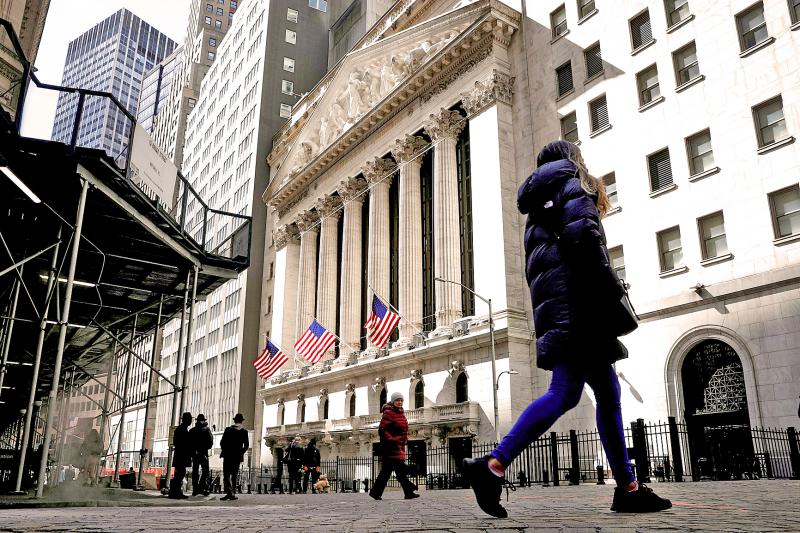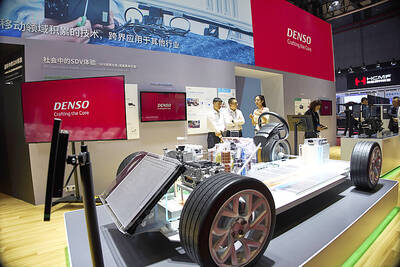Apple Inc’s iPhone 13 debut was met with a stock slump on Tuesday, keeping with a tradition of poor share price performance on the day new devices are unveiled.
Shares of the technology giant sank after Apple executives, including chief executive officer Tim Cook, presented the new lineup of phones and other devices.
The stock fell 1 percent to close at US$148.12 in New York trading. Prior to Tuesday, Apple’s shares fell on three-quarters of the days Apple unveiled new iPhones, data compiled by Bloomberg showed.

Photo: Reuters
Excluding Apple’s 8.3 percent rally on the day cofounder Steve Jobs announced the first iPhone in 2007, Apple shares have fallen an average of 0.8 percent the day of a debut.
Sales of iPhones accounted for nearly half of Apple’s revenue last quarter.
The poor performance is probably the result of investors becoming accustomed to regular innovation from Apple and many of the details being reported prior to the presentations, Bespoke Investment Group said in a note to clients on Monday.
“Any positive impact of a new release has typically already been priced into the stock,” the research company said.
Apple shares have posted double-digit gains this year, on pace for their third annual climb, boosted by investor optimism on the company’s growth outlook, but the stock took a hit last week after a US federal judge ordered the firm to alter its App Store business model.
The shares posted their biggest drop in four months after the ruling, with the sell-off at one point wiping out US$85 billion in market value from the company.
Still, Wall Street is sanguine on the stock.
About 80 percent of 47 analysts covering Apple have a buy rating on the shares, with only two recommending to sell it, Bloomberg data showed.
On average, they expect Apple to climb another 11 percent over the next 12 months as of Monday’s closing price.
On Tuesday, the Cupertino, California-based company introduced four iPhone 13 models with some minor enhancements, including a faster processor, better camera, longer battery life and nicer displays.
They are similar in design to last year’s iPhones, other than a smaller notch for the front-facing camera on top of the screen, and they start at the same price points.
Two new iPhone Pro models would have a higher-quality video-recording feature and a smoother-scrolling display that updates more frequently, along with the ability to expand storage to 1 terabyte — double the capacity of the biggest option last year.
After last year’s big 5G upgrade, the incremental nature of this year’s improvements might be a letdown to some and offer little incentive to upgrade.
Moreover, the overall picture for iPhone 13 demand might be mixed for the coming year.
Surveys show consumers are less inclined to spend big money for minor feature additions and are holding their current phones longer.
Last week, Piper Sandler published data that showed a considerable lack of interest in Apple’s next-generation smartphones.
The firm’s survey of 1,000 Americans showed that only 6 percent of the respondents said they planned to buy the iPhone 13 this fall or winter, down significantly from 10 percent last year.

GROWING OWINGS: While Luxembourg and China swapped the top three spots, the US continued to be the largest exposure for Taiwan for the 41st consecutive quarter The US remained the largest debtor nation to Taiwan’s banking sector for the 41st consecutive quarter at the end of September, after local banks’ exposure to the US market rose more than 2 percent from three months earlier, the central bank said. Exposure to the US increased to US$198.896 billion, up US$4.026 billion, or 2.07 percent, from US$194.87 billion in the previous quarter, data released by the central bank showed on Friday. Of the increase, about US$1.4 billion came from banks’ investments in securitized products and interbank loans in the US, while another US$2.6 billion stemmed from trust assets, including mutual funds,

AI TALENT: No financial details were released about the deal, in which top Groq executives, including its CEO, would join Nvidia to help advance the technology Nvidia Corp has agreed to a licensing deal with artificial intelligence (AI) start-up Groq, furthering its investments in companies connected to the AI boom and gaining the right to add a new type of technology to its products. The world’s largest publicly traded company has paid for the right to use Groq’s technology and is to integrate its chip design into future products. Some of the start-up’s executives are leaving to join Nvidia to help with that effort, the companies said. Groq would continue as an independent company with a new chief executive, it said on Wednesday in a post on its Web

JOINT EFFORTS: MediaTek would partner with Denso to develop custom chips to support the car-part specialist company’s driver-assist systems in an expanding market MediaTek Inc (聯發科), the world’s largest mobile phone chip designer, yesterday said it is working closely with Japan’s Denso Corp to build a custom automotive system-on-chip (SoC) solution tailored for advanced driver-assistance systems and cockpit systems, adding another customer to its new application-specific IC (ASIC) business. This effort merges Denso’s automotive-grade safety expertise and deep vehicle integration with MediaTek’s technologies cultivated through the development of Media- Tek’s Dimensity AX, leveraging efficient, high-performance SoCs and artificial intelligence (AI) capabilities to offer a scalable, production-ready platform for next-generation driver assistance, the company said in a statement yesterday. “Through this collaboration, we are bringing two

Even as the US is embarked on a bitter rivalry with China over the deployment of artificial intelligence (AI), Chinese technology is quietly making inroads into the US market. Despite considerable geopolitical tensions, Chinese open-source AI models are winning over a growing number of programmers and companies in the US. These are different from the closed generative AI models that have become household names — ChatGPT-maker OpenAI or Google’s Gemini — whose inner workings are fiercely protected. In contrast, “open” models offered by many Chinese rivals, from Alibaba (阿里巴巴) to DeepSeek (深度求索), allow programmers to customize parts of the software to suit their